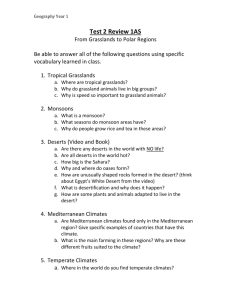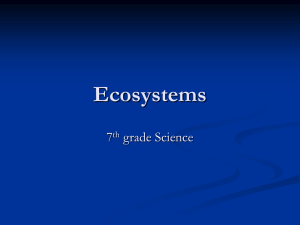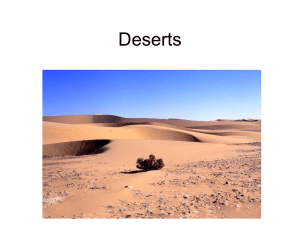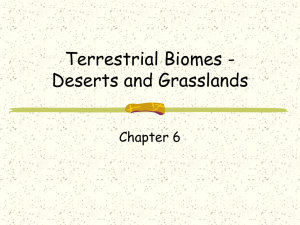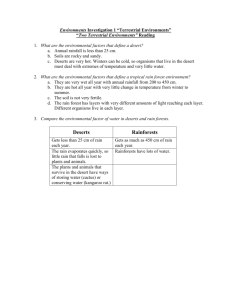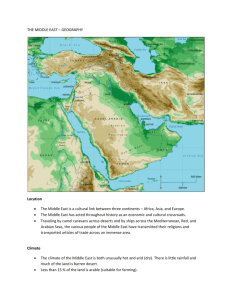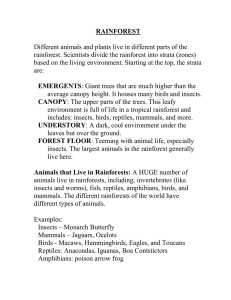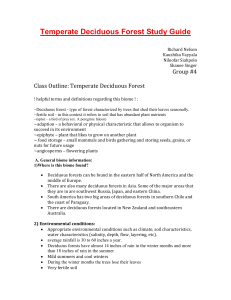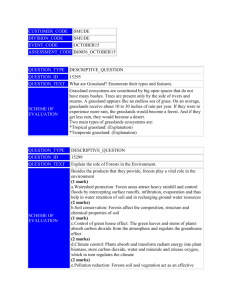chapter 7: desert and tundra 7.1 deserts
advertisement
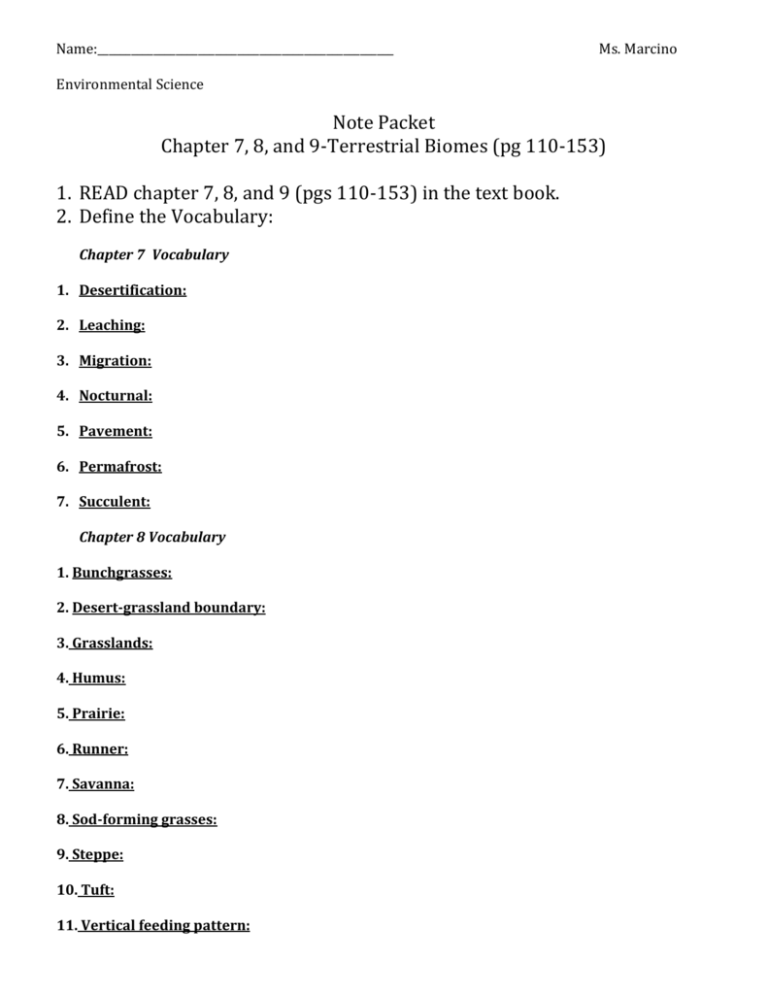
Name:_____________________________________________________ Ms. Marcino Environmental Science Note Packet Chapter 7, 8, and 9-Terrestrial Biomes (pg 110-153) 1. READ chapter 7, 8, and 9 (pgs 110-153) in the text book. 2. Define the Vocabulary: Chapter 7 Vocabulary 1. Desertification: 2. Leaching: 3. Migration: 4. Nocturnal: 5. Pavement: 6. Permafrost: 7. Succulent: Chapter 8 Vocabulary 1. Bunchgrasses: 2. Desert-grassland boundary: 3. Grasslands: 4. Humus: 5. Prairie: 6. Runner: 7. Savanna: 8. Sod-forming grasses: 9. Steppe: 10. Tuft: 11. Vertical feeding pattern: Chapter 9 Vocabulary 1. Conifer: 2. Deciduous tree: 3. Deforestation: 4. Rain forest: CHAPTER 7: DESERT AND TUNDRA 7.1 DESERTS All ____________________ receive very little _______________________. Soil rich in __________________________________; poor in ______________________________________________. Lack of ______________________________________________________: Leaching: Not many ________________________. Slows ________________________ of _____________________________________________. ______________ much ______________________________. Pavement: 2 Main Types (in U.S.) 1. __________________________________________ 2. __________________________________________ Cool ____________________________________ ______________________________________________ and ________________________________________ __________________ Deserts _______________________________________ (Arizona, New Mexico, Texas) DESERT CLIMATE Less than ____________________________ precipitation per year. Few _________________________________________________________________________ with long, dry periods. Large change in temperature in _______________________________________________________. DESERT ORGANISMS Desert Plants Able to ______________________________________________________________________ and prevent loss from _____________________. _________________________: Spines ______________________________________________________. Store ________________________________________________________. Spines protect from _________________________________________. Succulents: Plant roots ____________________________________________________ growing over wide area allow ________________________________________________________________________________________. Desert Animals Get water they need from _________________________________________. Insects and Reptiles _____________________________________________ to reduce water loss. Nocturnal: Most desert animals are nocturnal. CHECK FOR UNDERSTANDING: 1. What is meant by the pavement of a desert? 2. Explain why desert soil tends to be rich in minerals but poor in organic material. 3. Why are midday temperatures in the summer generally higher in deserts than in forests? 7.2 FORMATION OF DESERTS Natural _______________________________________________. Dry _______________________________________________________________________________________________. _________________________________________________________________________________________ towards Earth. Cool, dry air picks up the moisture in the soil and the ________________________________________. Called _________________________________________________. Desertification The process of _____________________________________________________________________________________ ______________________________________________________________________________________________________. Deserts _______________________________ by semiarid regions. CHECK FOR UNDERSTANDING: 1. How do semiarid regions differ from deserts? 2. Explain the role of mountains in the formation of deserts. 7.3 TUNDRA Location ___________________________ Hemisphere, south of __________________________________________. Cover ________________________________ of ___________________________________________________. Largest biome. Climate Less than ______________________________________________________________________________ per year. Temperatures usually below _____________________________________________________________. Permafrost: Rainfall during summer does not drain-____________________________________________________________ ___________________________________________________________________________________________________________. Tundra ___________________________ Small and _______________________________________________________________________________. Roots close to __________________________________. Trees are ____________________________________________________ (_____________________________________). ____________________________ Animals Seasonal Visitors Migration: __________________________________________________________________________________________________. Thick coats, _____________________________________________________________________ (insulation). CHECK FOR UNDERSTANDING: 1. What are lichens? What is their ecological role in the tundra? CHAPTER 8: GRASSLAND BIOMES 8.1 GRASSLANDS Grassland: Africa, ____________________________________________________________________________________________________. Grassland __________________________________ _________________________ than deserts. Desert-grassland boundary: Grassland ___________________________________________ _______________________________! Most of the grass plant is ______________________________-not limited by ________________________. Fire Keep grass from ___________________________________________________________________. Burn away __________________________________________________________________________. ________________________ nutrients. Allow _______________________________________ of grass __________________________. Some plants are drought-resistant. Grazing animals Bison! Keep ____________________________ close to ground. _________________________________________________________________ (prairie dogs, earthworms, etc). ________________________________seasons and _________________________ seasons. Determine what kinds of organisms live here. Divided into: _________________________________ _________________________________ _________________________________ CHECK FOR UNDERSTANDING: 1. Where are grasslands located in relation to deserts and forests? 2. Identify some biotic and abiotic factors affecting the growth of grasslands. 8.2 STEPPES AND PRAIRIES Steppes: Located to the ______________________________________________________________. Prairie: Steppe and Prairie Climates Steppe-_________________________________________________________________________________________________ __________________________________________________________________________________________________________ Prairie-_________________________________________________________________________________________________ Steppe and Prairie Organisms Sod-forming grasses: Roots prevent soil from _______________________________________________________________________. Humus: Bunchgrasses: Roots ____________________________________________________________________________________________. Animals Migrate, hibernate, burrow underground. CHECK FOR UNDERSTANDING: 1. How does the activity of burrowing animals benefit the prairie? 2. Name some ways in which steppes and prairies are damaged and desertification develops. 8.3 SAVANNAS Savannas: Asia, _______________________________________________________________________. Savanna Climate Rainy seasons followed by ___________________________________. _________________________________________________________________________________________. Savanna Organisms Resistant to ___________________________________________________________________________. Runners: Tufts: Trees and shrubs have _________________________________________________________ to protect against grazing. ______________________ rapidly. Many animals ________________________________________________________________________________ (giraffes, antelopes, elephants). Vertical feeding pattern: CHECK FOR UNDERSTANDING: 1. What is the purpose of growing runners? 2. How have plants adapted to savanna life? 3. What could happen to the migrating animals in a savanna if they were fenced in a large wildlife park for protection? CHAPTER 9: FOREST BIOMES 9.1 CONIFEROUS FORESTS ______________________________ Hemisphere Warm summer, ________________________________________________. ___________________________________________ winters _________________________________________________________ per year. Conifers: _________________ like leaves, covered in _________________ substance. Do not lose their “_____________________________”. Conserve water, shed _____________________________________________________. Examples:___________________________________________________________________. Soil _______________________________________________________. Snow fall traps ___________________ and prevents ground from _______________________________________. Small _________________________________ eat seeds. ________________________ tree roots. _____________________________________________________________________. Large herbivore eat ___________________________________________________. Elk, moose, beavers, snowshoe hares. CHECK FOR UNDERSTANDING: 1. What does the word coniferous mean? 9.2 DECIDUOUS FORESTS __________________________________ zones. Deciduous tree: Temperatures: ____________________________________________________________________. _________________________________________________________, falls regularly. Growing season lasts ____________________________________. ______________________________________ and produce lots of food. _____________________________________ and go _________________ during autumn. Examples:_________________________________________________________________________________________. Canopy: Made of _______________________________________________________________________________. Captures most of ________________________________________. Understory: __________________ beneath understory. ______________________________, ___________________________________________________________________floor. Falling leaves ________________________________________ and add _________________________________________. Diverse plant and animal life. Humans consume forest-_______________________________________________________________________________ ____________________________________________________________________________________________________________. CHECK FOR UNDERSTANDING: 1. Why is the soil of a deciduous forest more fertile than that of a coniferous forest? 9.3 RAIN FORESTS Temperatures about _____________________________________________. ___________________________________________________________________________ 12 months. ______________________________________________________________________________________ per year. Rain forest structure. Rain forest: Most _____________________ and _________________________ biome. Trees (_________________________________________________________________________________) Reach heights of ______________________ meters. Canopy captures ______________________________________. Sparse _________________________ on forest floor. Almost all ___________________________ contained in _____________________________________________. _______________________________________, poor in ________________________________. Organic matter consumed so quickly by other organisms. __________________ tree roots. Organisms and Diversity Due to: _________________________________________________________ plants. __________________________________________________________ of habitats. Deforestation ___________________________________________________________________________________ human activity. Need for _________________________________________________ = driving force. CHECK FOR UNDERSTANDING: 1. Why do rainforest trees have buttresses? 2. Plants on the floor of a rain forest often have very large leaves. Propose a hypothesis explaining this observation.

